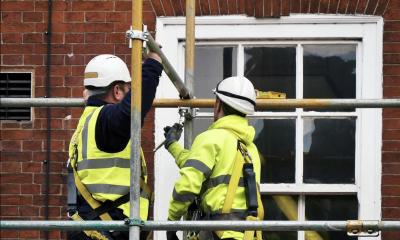
Putting up scaffolding is skilled and technical work and you'll need to make sure you're fully aware of safety issues. Get the essentials for starting up and running your own scaffolding business in our practical guide.
- Research your target market
- Decide which scaffolding services to offer
- Consider your work rate
- Price your scaffolding services
- Promote your scaffolding business
- Buy an existing scaffolding business
Research your target market
When you plan your scaffolding business it's very important to think carefully about who your customers will be and how much existing competition there is.
Customers
Think about who is likely to use your scaffolding services. Much of your work is likely to come from other businesses in the construction industry.
Sub-contract work
Many construction projects will require some form of elevated access, both on the outside and possibly on the inside of the building or structure. Try approaching businesses such as general builders, roofers, civil engineers, painters and decorators and so on. Your aim is to make sure that as many businesses as possible in your area that require scaffolding on a regular basis have your contact details, and a good reason for giving your business a try.
Think about other types of business that might frequently require scaffolding. For example, industrial contract cleaners often need high-level access to the outside of tall structures, as do steeplejacks and even shipbuilders.
Work for other businesses and organisations
Other types of businesses might contact you directly if they need scaffolding. For example, event organisers and concert promoters may require scaffolding for podiums, stages and similar temporary structures, as may film and television companies.
Industrial plants, factories, farms, dockyards and shipping, offices and shops might also require your services from time to time. Consider approaching your local authority - these are major users of construction services and may be prepared to include your business on a list of 'approved contractors'.
Once you have identified your potential customers, you can direct your advertising efforts at them.
Domestic work
Some householders might contact your business directly when they need scaffolding for a DIY project. Such projects might include exterior painting and general maintenance. You might hire out lightweight portable scaffold towers for smaller domestic jobs.
Pay attention to the type of housing in your area. For example, is housing one, two or multi-storey? Is accommodation mainly owner-occupied or mainly rented? Is some owned by the local authority or by a housing association?
Establishing the level of competition
Once you have decided who your customers might be, you need to find out how well they are already served.
How many other scaffolding firms are there in your area? Search online to identify how many similar businesses there are in your area. How many offer the same services that you intend to offer? These are your direct competitors. Bear in mind that there may be other scaffolders working in the area who don't advertise anywhere but obtain most of their work through a network of contacts within the industry.
Look out for outlets owned by major national plant and tool hire companies like HSS and Brandon Hire (and also the builders' merchant Jewson). Although don't offer a full scaffolding service, they do hire out access equipment like towers, stagings and powered-access platforms.
Try to find out what services your competitors offer:
- what services do they offer
- do they advertise any special features, for example, a 24-hour service
- do they belong to a trade association, for example, the National Access and Scaffolding Confederation (NASC)
- what impression do their website, Google Business profile and social media profiles give you (for example, does the firm come across as small and friendly, large and efficient, good value?)
Health and safety for scaffolders
Working at height as a scaffolder is potentially very hazardous. It is essential that you take health and safety regulations seriously.
The Health and Safety at Work Act covers all aspects of health and safety. The health and safety aspects of construction based activities are specifically covered by the Construction (Design and Management) Regulations. These were overhauled and updated in 2015 and apply to temporary structures such as event stages, as well as to more traditional construction projects. They can apply to domestic as well as commercial construction works. You can find out more about the CDM regulations on the Health and Safety Executive website.
The Work at Height Regulations cover all work done at height. They place very specific duties on employers and self-employed workers including:
- assessing all risks
- planning and organising all work at height
- making sure people are competent
- making sure all equipment is safe and appropriate
Other key areas of health and safety include:
- use of electrical equipment (power tools and so on)
- access to first aid equipment
- protective clothing and equipment
- reporting of any accidents at work
You must comply with workplace health and safety and fire safety legislation.
Remember, taking a scaffold competent person training course can significantly enhance your knowledge and skills. It will help you stay up to date with the latest safety regulations and techniques. Moreover, possessing a recognised qualification can boost your credibility and reputation as a scaffolder, making it easier to attract clients and secure contracts. By investing in training and continuously refining your services, you'll benefit both yourself and your clients.
Insurance for scaffolders
The hazardous nature of working at height makes insurance cover essential. You will need to arrange insurance cover as soon as you start your business. Contact an insurer and explain how your business will operate so can tell you what insurance you will need. This could include:
- employer's liability
- public liability, including sufficient cover in the event of a failure of one of your scaffolds
- contract and professional indemnity
- product liability
- premises, premises contents
- plant, equipment and assets - including on-site cover and hired-in plant
- motor insurance (for business vehicles), possibly including cover for equipment carried in your vehicles
- personal cover, including accident and injury, loss of earnings and so on
- business interruption
Some professional associations and 'approved contractor' schemes require all participating businesses to have a minimum level of public liability insurance.
Business insurance policies for construction firms can be expensive so it pays to shop around.
The National Access and Scaffolding Confederation (NASC) requires its members to have adequate levels of both public liability and employer's liability insurance. NASC has negotiated preferential insurance rates for its members and can provide insurance advice.
Research current trends, plus legal and tax issues
Compare business bank accounts
If you’re starting up or looking to switch bank accounts, Nerdwallet also have a free business bank account comparison tool.
Decide which scaffolding services to offer
You will probably work on both new and existing buildings. Some of the construction projects that you might provide access services for include:
- general building work, including repairs, maintenance and improvement, to a variety of different buildings including domestic houses and commercial and industrial premises
- maintenance and repair of listed buildings and monuments
- roofing work and chimney repairs
- painting, decorating and cleaning (for example the outsides of high buildings)
- civil engineering, including bridge building and maintenance
As well as construction projects, you might also offer specialist access services and scaffolding for the following:
- marine engineering and shipbuilding
- temporary structures for special events, such as pop concerts and sporting events
- film and television sets
- heavy industry, for example petro-chemical plants and offshore oil platforms
- agriculture
- hygiene-sensitive areas (for example food preparation factories)
- hazardous areas
There are several different scaffolding systems and techniques available, some of which are particularly suitable for certain applications. You might decide to develop specialist expertise in complex designed scaffolds like cantilevers, birdcages and bridge scaffolds.
For most scaffolding contracts you will be expected to erect and dismantle the scaffolding as required. In some cases, you might also be required to modify and/or expand the scaffold during the course of the project. For major projects, you may be asked to provide detailed design and consultancy services.
Many scaffolds will require 'extras' such as rubbish chutes, lifts and conveyors, spine beams, safety netting, tarpaulin screens and weather-proofing, and so on.
You might decide to specialise in a particular type of access provision. This might necessitate specialist equipment and training. For example, scaffolds erected at sites where hygiene is important are often made from special materials such as glassfibre reinforced plastic (GRP). Similarly, GRP scaffolding may be required at sites where non-conductive equipment is needed for safety reasons.
Other services
As well as scaffolding work, you might decide to offer various other services. Some examples include:
- specialist access services, for example rope access, 'bosun's chair' and 'cherry picker' access
- crane hire
- skip hire
- other plant hire
- asbestos removal
- sales of new and used scaffolding equipment
You might even decide to offer services such as roofing work or remedial stonemasonry, depending on the skills that you have available.
Quality of service
The scaffolding industry is competitive and you may decide to offer your customers a range of 'added value' services. These might include, for example:
- free estimates and quotations
- a high level of public liability insurance
- membership of a recognised trade association
- training of all operatives
- safety audit and certification, for example using the SCAFFTAG system
- 24-hour, seven day emergency service
- a 'no job too small' promise
Consider your work rate
Assuming that you get a fairly steady stream of work, the amount that you can earn depends partly on the number of days you work and the length of your working day.
You may decide to stick to normal business hours, for example 8.30 am until 5.30 pm Monday to Friday and perhaps Saturdays too. Or you may decide to work longer hours. Remember though that bad weather can disrupt your work schedules. Perhaps you are prepared to work very long hours when the weather is fair and your services are in demand, taking some time off during quieter periods.
Erecting and dismantling scaffolding normally requires a team of at least two people. So, you will probably need to make sure that there is somebody available to work with you during your hours of business.
Some scaffolding and access firms offer a 24-hour service. If you intend to offer this service you will need to make sure that you can provide cover at all times, perhaps by taking on extra employees or a business partner. In some cases you will specifically be required to work outside normal business hours. For example, for safety reasons it is quite usual for scaffolds sited in busy public places to be erected and dismantled during the evening or night. Similarly, internal scaffolding that's needed in workplaces may also have to be worked on at night when the building is empty.
Work rate
As an experienced scaffolder, you should have an idea of how long certain types of job will take you. It is very important when quoting for a job that you can make an accurate estimate of how long it will take. It's no good quoting based on one day's work if it ends up taking you three!
The speed at which you work will depend on your skills and experience, the type of work you do, the nature of the site you are working and the complexity of the job. Your charges should reflect all of these things.
Non-productive time
Unfortunately, you won't be earning money every hour of the working day. Here are a few reasons why you will sometimes find yourself working hard but earning nothing:
- visiting sites to cost new work
- finishing off jobs that take you longer than you had thought (possibly due to unforeseen problems)
- travelling to and from jobs, or going to get equipment from your base or a supplier
- repairing equipment or vehicles
Sometimes you will find that you are unable to work at all, because:
- the weather is too bad to work outside
- another contractor has fallen behind with his or her part of the project
- you are waiting for equipment to be delivered
- a vital piece of equipment is broken
- you are ill or even injured
Remember that the above can apply to your employees as well as to you. Take all of these factors into account when you are estimating the maximum number of productive hours that you and your employees can work each month.
Price your scaffolding services
How will you decide on your prices?
First decide how you will charge for the work you do. For example, you might base your charges on the approximate area or meterage of building to be covered, making allowances for the type of scaffold required and any special requirements such as waste chutes, safety netting, weather-proof coverings and so on. Alternatively, you might cost each job on the basis of the amount of equipment required, once again taking into account any extras and special requirements. You may decide to use different methods of costing for different jobs, depending on who the customer is and what the job is like.
In some cases, it may be possible to quote a price from experience - for example, you may be very familiar with the amount of scaffold required to cover a particular type of house within your local area. In other cases, however, it may be necessary to carry out quite a detailed costing exercise to work out how much to charge. This might include technical drawings or even computer aided design (CAD). Complex scaffolds like dead and flying shores, bridge scaffolds and spectator terraces will all need to be professionally designed.
Decide whether you will charge for scaffolds on a weekly or monthly basis, or whether you will charge a fixed price irrespective of how long (within reason!) the scaffolding remains in place. The basis on which you charge for scaffolding might vary from one client to the next, depending on who they are and how often they use your services.
Be clear about what will be included in your 'basic' price for a scaffold, and what will be charged for as an extra. For example, you might usually include erection and dismantling as part of your basic charge, but make an extra charge for any additional labour required to modify the scaffold during the course of a project. Sometimes you might provide your own services, and those of any employees, on a labour-only basis.
It is very important that you set your charges carefully. You must make sure when deciding on what to charge that, assuming you get enough work, you will earn enough to cover all of your operating costs, including your own drawings.
You should also consider the following points when setting your charges:
- what do your competitors charge for a similar level of service
- whether you will try to win business from your competitors with attractive pricing
- whether you vary your rate depending on the type and complexity of the work involved
- whether you will offer special pricing for specific customers (for example, if you are working on a long-term project for a client)
- whether you will add a margin on any extra equipment you have to hire out for a job, or whether you price this at cost
Quote or estimate
If you give a fixed-price quote for a job, it cannot be changed once it has been accepted by a customer, even if the job ends up being a lot more work than anticipated when you prepared the quote. So, it's very important that your quotes give precise details of what is covered and clarify that any variations or extras not covered by the quote will be charged as extras.
An estimate is not a fixed price, it's just your best guess of what the job is likely to cost. You are not bound by it. It is perfectly acceptable to provide several estimates, each taking into account different circumstances from best to worst-case scenario.
If necessary, explain to customers what could lead to the price for a job changing - for example modifications to the original specification or a request for additional scaffolding. And if the customer asks for modifications during the course of a job, be clear about how this will affect the overall cost.
It's usual to provide estimates and quotes free of charge on a no-obligation basis. You might decide to make a charge for more complex and time-consuming consultancy work but refund this charge if it leads to a substantial contract.
Trade rates
Business clients might expect you to offer them a special 'trade rate'. Large organisations that invite firms like yours to tender for contract work will also expect your rates to be competitive, as will insurance companies.
Many of these clients will get quotes from several scaffolding firms, so you need to be able to quote accurately and competitively. Large organisations that invite firms such as yours to tender for sub-contract work will expect your rates to be very competitive. However, don't cut your own throat. Many clients value a good, efficient, and above all safe service and are prepared to pay a realistic price for it. Make sure that you don't end up working at a loss because your quote was too low!
A quick search online will give you a guide to the going rate for all aspects of scaffolding and access work. Remember, price-conscious customers will have access to the same information, so you would be wise to keep your prices in line with this information.
Promote your scaffolding business
It is important to advertise your business effectively, to let your potential customers know who you are, where you are and what you can do for them.
Advertising and marketing
Most people search for services, such as scaffolding, online these days. A good website can be an effective way of advertising your business and reaching a wider range of customers. Make sure you include photographs of previous work and customer reviews.
Think about getting listed in online directories - perhaps 'contact an expert' directories run by some trade associations. Consider signing up to one of the review websites for tradespeople such as Checkatrade. You could also register to the job-referral websites like Mybuilder.com and Rated People too.
Make sure you set up a Google Business Profile so you appear in local searches. Include details of the services you offer and customer reviews.
Make sure you have a presence on social media. For example, sign up to Next Door. Users of this app often ask for local recommendations and you can reply by offering your services. It's also worth encouraging your customers to post recommendations on Next Door - once three people have done this, your business will start to appear in searches.
Some firms spend a lot of money on large, eye-catching display advertisements. You will have to decide whether to compete head on with these firms, or look for a different way of attracting customers. You could, for example:
- focus on your own unique selling point (USP) in your advertising material. This might be, for example, "25-years' experience", "Family run firm" or even simply "Friendly, honest service"
- advertise in other ways. For example, mail a flyer to local households with your business name, details of the services you offer and contact details, perhaps in the early spring
- look into becoming listed by an insurer, specialist helpline or directory as an 'approved tradesman' (most of these organisations operate a quality screening process and some will only list firms that have been trading for at least two years)
- contact local residential landlords associations to enquire about being included in their suppliers' guide
The important thing is to tell people as many of the good things about your business as possible in your advertisements, particularly things that distinguish your business from your competitors.
Other ways of advertising
Your local paper may run a regular 'contact the experts' advertising feature. If you want to advertise to a wider audience, consider trade journals for the building industry.
A direct mailshot can be a cheap but effective means of advertising your services. Sponsorship of a local sports team or event might also prove effective.
Remember that your vehicle can be a very effective means of advertising if you have it sign-written and keep it clean and presentable. A well-designed sign or banner, with your business name, logo and contact details on it, could be attached prominently to each of your scaffolds.
Word of mouth
Word-of-mouth recommendations are very valuable to your business. Everyone has heard horror stories about 'cowboy' tradesmen - and they want to be sure you're not one of them. You will have to earn your reputation through good, reliable workmanship - but even small things like being polite and considerate can pay big dividends. Make sure that any staff you employ are good ambassadors for your business too.
Try to build up a network of key contacts within the local construction industry. You might also look into becoming listed by a local authority as an 'approved contractor'.
Buy an existing scaffolding business
You might decide to buy an existing scaffolding business rather than start your own venture from scratch.Buying a going concern can mean that customers, staff, premises and equipment are already in place.
Make sure that the business does not have any outstanding liabilities - for example unsettled claims for compensation - before making any commitment to buy.
If there are established regular customers and other important contacts, take the trouble to go out and meet them soon after you take over the business. Some of them will have built up a good relationship with the former proprietor over the years and may be wary about a change of ownership. You may be able to get the former proprietor to introduce you personally.
Buying a business can be a hazardous, expensive process unless you have the right skills and experience on your team, including legal and financial know-how. Establish the genuine trading and financial position, so that the price you pay for the business is fair.



